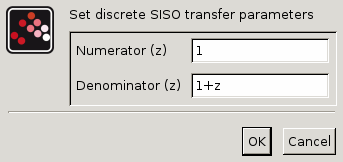DLR
Discrete transfer function
Block Screenshot

Contents
Palette
Description
This block realizes a SISO linear system represented by its rational transfer function (in the symbolic variable z). The rational function must be proper.
Dialog box

Numerator (z)
This parameter sets the numerator of the transfer function.
This must be a polynomial inz .
Properties : Type 'pol' of size 1.
Denominator (z)
This parameter sets the denominator of the transfer function.
This must be a polynomial inz .
Properties : Type 'pol' of size 1.
Default properties
always active: no
direct-feedthrough: no
zero-crossing: no
mode: no
regular inputs:
- port 1 : size [1,1] / type 1
regular outputs:
- port 1 : size [1,1] / type 1
number/sizes of activation inputs: 1
number/sizes of activation outputs: 0
continuous-time state: no
discrete-time state: yes
object discrete-time state: no
name of computational function: dsslti4
Interfacing function
SCI/modules/scicos_blocks/macros/Linear/DLR.sci
Computational function
SCI/modules/scicos_blocks/src/c/dsslti4.c (Type 4)
Comments
As a new user of XCOS and SciLab I sometimes struggle with the brief descriptions of things in the HELP.
For the DLR in XCOS (or discrete transfer function), for example, it might be useful to provide an example of a transfer functions with a higher power of 'z' than 1 in order to explain the format of 'z powers' to the user and make it easier to use.
eg:
numerator = 0.5*(1+%z^2)
denominator = 1 - %z^2
Also, it there a way to 'initialise a transfer functions state/history values
I want to set the initial conditions for a simulation run e.g. y(z)(z^-1) etc. Is this possible? If you dont know what I mean - its kind of like initialising an integrator in the algorithmic form of a PID controller, where the integral sum is a serparate variable.
Nick.
Add a comment:
Please login to comment this page.